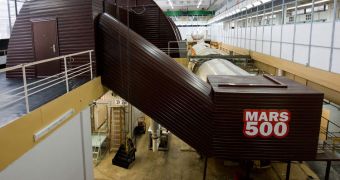Six “astronauts” currently locked in a test facility in Russia will “return to Earth” on Friday, November 4, officials from European and Russian space agencies (ESA and RosCosmos) announce. The six volunteers have been locked inside the test facility since mid-2010.
The purpose of the Mars500 experiment is to simulate the conditions that real astronauts would experience as they travel to the surface of the Red Planet, and back. Such a mission would last at least one-and-a-half years, which is why this experiment lasted for as long as they did.
Participants are locked down in a series of interconnected modules at the Moscow, Russia-based Institute of Biomedical Problems (IBMP). The facility is meant to simulate the conditions inside a prospective spacecraft that would travel to Mars.
At this point, as technological and engineering challenges are being addressed, the human factor remains the only loose card mission controllers need to compensate for. This simulated, 520-day journey to Mars was meant to be a psychological experiment above all.
Researchers are very interested in learning how seclusion and isolation affects the human brain, especially when only a handful of individuals are locked together in a confined space. Prolonged periods of isolation can give birth to animosities and conflicts, which could endanger the mission.
Over the coming months, scientists will continue to peer over the data they collected during the past 18 months, and derive statistical projections based on them. This will help mission controllers set up new and improved mission plans that would maximize the potential success of a Martian mission.
“At last the countdown embodies the feeling that was constantly growing throughout October: the end is close!” says Mars500 crewmember Romain Charles, a French engineer who was selected by ESA.
“Our international crew went through the Mars500 mission successfully and we're happy and proud to answer positively to the question asked one year and a half ago: 'Is Man able to endure, physiologically and psychologically, the confinement of a trip to Mars?' Yes, we're ready to go!” he adds.
“I don't know about the guys inside, but for us on the outside, looking back, it seems like it wasn't that long ago since they started,” says ESA Directorate of Human Spaceflight and Operations (DHSO) Science and Application Division (SAD) leader Christer Fuglesang.
“The length of Mars500 is unique – there has never been such a long isolation before, so that gives you unique data,” the official tells Space. Fuglesang is also an ESA astronaut.
“From a logistics and communications point of view, it was quite realistic. Of course, there are certain aspects that you cannot simulate. You cannot simulate weightlessness or radiation, for example,” he concludes.

 14 DAY TRIAL //
14 DAY TRIAL //